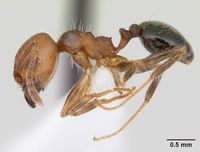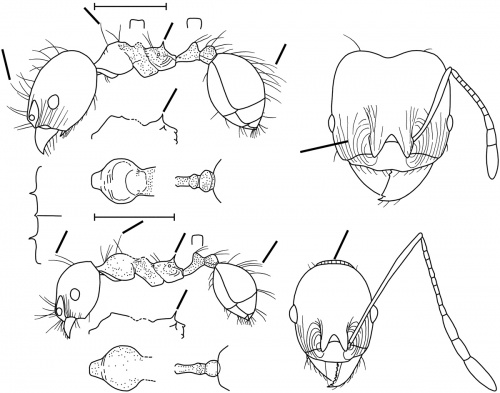Pheidole pubiventris
| Pheidole pubiventris | |
|---|---|

| |
| Scientific classification | |
| Kingdom: | Animalia |
| Phylum: | Arthropoda |
| Class: | Insecta |
| Order: | Hymenoptera |
| Family: | Formicidae |
| Subfamily: | Myrmicinae |
| Tribe: | Attini |
| Genus: | Pheidole |
| Species group: | diligens |
| Species: | P. pubiventris |
| Binomial name | |
| Pheidole pubiventris Mayr, 1887 | |
| Synonyms | |
| |
This species occurs in open areas and synanthropic habitats. This species appears to have a broad range, as often occurs in species favoring synanthropic habitats, but it is also infrequently collected and, among the few collections, shows a high degree of variability. A winged queen was collected at El Campano in June. (Wilson 2003, Longino 2009)
| At a Glance | • Limited invasive |
Identification
See the description in the nomenclature section.
Keys including this Species
Distribution
Southern Brazil to Mexico.
Latitudinal Distribution Pattern
Latitudinal Range: 18.6° to -29.7°.
| North Temperate |
North Subtropical |
Tropical | South Subtropical |
South Temperate |
- Source: AntMaps
Distribution based on Regional Taxon Lists
Neotropical Region: Brazil (type locality), Colombia, Costa Rica, Ecuador, Guatemala, Mexico.
Distribution based on AntMaps
Distribution based on AntWeb specimens
Check data from AntWeb
Countries Occupied
| Number of countries occupied by this species based on AntWiki Regional Taxon Lists. In general, fewer countries occupied indicates a narrower range, while more countries indicates a more widespread species. |

|
Estimated Abundance
| Relative abundance based on number of AntMaps records per species (this species within the purple bar). Fewer records (to the left) indicates a less abundant/encountered species while more records (to the right) indicates more abundant/encountered species. |

|
Biology
Castes
Worker
Minor
Images from AntWeb
   
| |
| Worker. Specimen code jtlc000007354. Photographer April Nobile, uploaded by California Academy of Sciences. | Owned by JTLC. |
Nomenclature
The following information is derived from Barry Bolton's Online Catalogue of the Ants of the World.
- pubiventris. Pheidole pubiventris Mayr, 1887: 595 (s.), 604 (w.), 607 (q.) BRAZIL. Senior synonym of cearensis, nevadensis, timmii: Wilson, 2003: 218; of indistincta, variegata: Longino, 2009: 66.
- variegata. Pheidole pubiventris subsp. variegata Emery, 1896g: 72 (s.w.q.) COSTA RICA. Forel, 1908b: 54 (m.). Raised to species: Wilson, 2003: 245. Junior synonym of pubiventris: Longino, 2009: 66.
- indistincta. Pheidole indistincta Forel, 1899c: 75 (s.w.) COSTA RICA. Junior synonym of pubiventris: Longino, 2009: 66. See also: Wilson, 2003: 196.
- cearensis. Pheidole pubiventris r. cearensis Forel, 1901e: 353 (s.w.) BRAZIL. Junior synonym of pubiventris: Wilson, 2003: 218.
- nevadensis. Pheidole pubiventris var. nevadensis Forel, 1901e: 353 (s.w.q.) COLOMBIA. Junior synonym of pubiventris: Wilson, 2003: 218.
- timmii. Pheidole pubiventris r. timmii Forel, 1901h: 62 (s.w.) U.S.A. Incertae sedis in Myrmicinae: Smith, D.R. 1979: 1414. Junior synonym of pubiventris: Wilson, 2003: 218.
Unless otherwise noted the text for the remainder of this section is reported from the publication that includes the original description.
Description
From Wilson (2003): A medium-sized brown member of the diligens group with relatively sparse, extremely long, erect to suberect curving hairs over the dorsa of the head and body.
Major: sculpturing of head consists entirely of carinulae, which are confined to the anterior half of the head capsule; promesonotal profile trilobous and pronotal humerus subangulate in dorsal-oblique view.
Minor: humerus angulate; pronotum mostly foveolate and opaque.
Similar to Pheidole longiseta, Pheidole sensitiva and Pheidole variegata (= Pheidole pubiventris); differing in many details of body form, sculpturing, and pilosity, as illustrated.
See also the less similar Pheidole blumenauensis, Pheidole rochai, Pheidole seeldrayersi and Pheidole vafra.
Majors from Colombia have shorter pilosity and more angulate humeri than the Brazilian series; and thus may represent a distinct species.
MEASUREMENTS (mm) Syntype major (Mus. Comp. Zool. Harvard): HW 1.14, HL 1.12, SL 0.86, EL 0.22, PW 0.56. Syntype minor (Mus. Comp. Zool. Harvard): HW 0.54, HL 0.68, SL 0.86, EL 0.16, PW 0.40.
COLOR Major: light reddish yellow (probably a callow or faded; fresher specimens are blackish brown).
Minor: body medium brown, with light brown appendages (fresher specimens are blackish brown).
Figure. Upper: syntype, major. Lower: syntype, minor. The specimens illustrated are from the Museum of Comparative Zoology. Scale bars = 1 mm.
Type Material
Longino (2009):
Syntype major worker, minor worker, queen: Brazil, Santa Catarina (Hetschko) NMW, Museum of Comparative Zoology (examined).
Pheidole pubiventris subsp. variegata Lectotype major worker (here designated, as labeled by Wilson 2003) and associated paralectotype minor worker, queen: Costa Rica, San José (Alfaro) Musee d'Histoire Naturelle Genève (not examined).
Pheidole indistincta Lectotype major worker (here designated, as labeled by Wilson 2003): Costa Rica (Tonduz) MHNG (examined).
Pheidole pubiventris r. cearensis Syntype major, minor worker: Brazil, Ceará, Biturité (Schmitt) (not examined).
Pheidole pubiventris r. nevadensis Syntype major, minor worker, queen: Colombia, Magdalena, San Antonio, >1000m elevation (Forel) (not examined).
Pheidole pubiventris r. timmii Syntype major, minor worker: U.S.A., Louisiana, New Orleans, "probably of Mexican origin" (Timm) (not examined).
Etymology
L pubiventris, hairy belly, evidently alluding to the conspicuously long pilosity of the gaster. (Wilson 2003)
References
- Wilson, E. O. 2003. Pheidole in the New World: A dominant, hyperdiverse ant genus. Harvard University Press, Cambridge, MA. (page 218, Senior synonym of cearensis, nevadensis, and timmii, fig. major, minor described)
- Casadei-Ferreira, A., Economo, E.P., Feitosa, R.M. 2020. Additions to the taxonomy of Pheidole (Hymenoptera: Formicidae) from the southern grasslands of Brazil. Revista Brasileira de Entomologia 64(4):e20200068 (doi:10.1590/1806-9665-RBENT-2020-0068).
- Lutinski, J., de Filtro, M., Baucke, L., Dorneles, F., Lutinski, C., Guarda, C. 2021. Ant assemblages (Hymenoptera: Formicidae) from areas under the direct influence of two small hydropower plants in Brazil. Brazilian Journal of Environmental Sciences (Online), 1-9 (doi:10.5327/Z217694781030).
- Mayr, G. 1887. Südamerikanische Formiciden. Verh. K-K. Zool.-Bot. Ges. Wien 37: 511-632 (page 595, 604, 607, soldier described, worker described, queen described)
- Longino, J.T. 2009. Additions to the taxonomy of New World Pheidole. Zootaxa 2181: 1-90. PDF
References based on Global Ant Biodiversity Informatics
- Dattilo W. et al. 2019. MEXICO ANTS: incidence and abundance along the Nearctic-Neotropical interface. Ecology https://doi.org/10.1002/ecy.2944
- De la Mora, A., J. A. Garcia-Ballinas, and S. M. Philpott. 2015. Local, landscape, and diversity drivers of predation services provided by ants in a coffee landscape in Chiapas, Mexico. Agriculture, Ecosystems & Environment 201: 83-91.
- Favretto M. A., E. Bortolon dos Santos, and C. J. Geuster. 2013. Entomofauna from West of Santa Catarina State, South of Brazil. EntomoBrasilis 6 (1): 42-63.
- Fernández, F. and S. Sendoya. 2004. Lista de las hormigas neotropicales. Biota Colombiana Volume 5, Number 1.
- Forel A. 1901. Variétés myrmécologiques. Annales de la Société Entomologique de Belgique 45: 334-382.
- Forel A. 1908. Fourmis de Costa-Rica récoltées par M. Paul Biolley. Bulletin de la Société Vaudoise des Sciences Naturelles 44: 35-72.
- Kempf W. W. 1978. A preliminary zoogeographical analysis of a regional ant fauna in Latin America. 114. Studia Entomologica 20: 43-62.
- Kempf, W.W. 1972. Catalago abreviado das formigas da regiao Neotropical (Hym. Formicidae) Studia Entomologica 15(1-4).
- Larsen, A., and S. M. Philpott. 2010. Twig-nesting ants: the hidden predators of the coffee berry borer in Chiapas, Mexico. Biotropica 42: 342-347.
- Longino J. T. 2009. Additions to the taxonomy of New World Pheidole (Hymenoptera: Formicidae). Zootaxa 2181: 1-90.
- Longino J. T., J. Coddington, and R. K. Colwell. 2002. The ant fauna of a tropical rain forest: estimating species richness three different ways. Ecology 83: 689-702.
- Lutinski J. A., B. C. Lopes, and A. B. B.de Morais. 2013. Diversidade de formigas urbanas (Hymenoptera: Formicidae) de dez cidades do sul do Brasil. Biota Neotrop. 13(3): 332-342.
- Menozzi C. 1926. Neue Ameisen aus Brasilien. Zoologischer Anzeiger. 69: 68-72.
- Rosa da Silva R. 1999. Formigas (Hymenoptera: Formicidae) do oeste de Santa Catarina: historico das coletas e lista atualizada das especies do Estado de Santa Catarina. Biotemas 12(2): 75-100.
- Santos-Junior L. C., J. M. Saraiva, R. Silvestre, and W. F. Antonialli-Junior. 2014. Evaluation of Insects that Exploit Temporary Protein Resources Emphasizing the Action of Ants (Hymenoptera, Formicidae) in a Neotropical Semi-deciduous Forest. Sociobiology 61(1): 43-51
- Smith M. A., W. Hallwachs, D. H. Janzen. 2014. Diversity and phylogenetic community structure of ants along a Costa Rican elevational gradient. Ecography 37(8): 720-731.
- Vásquez-Bolaños M. 2011. Lista de especies de hormigas (Hymenoptera: Formicidae) para México. Dugesiana 18: 95-133


